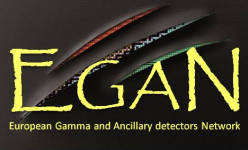Speaker
Enrico Farnea
(INFN PD)
Description
The expected experimental conditions at the planned future facilities for radioactive ion beams and for high-intensity stable beams are extremely challenging, requiring unprecedented levels of efficiency and sensitivity, which cannot be reached with the conventional 4π arrays of Compton-suppressed high-purity germanium detectors.
The approach pursued in the past few years implies covering the full 4π solid angle with germanium detectors only, and maximising the photopeak efficiency and the peak-to-total ratio through the identification of the interaction points of the photons within the germanium crystals (pulse shape analysis) and a software reconstruction of the trajectories of the individual photons (γ-ray tracking). The major advantage with respect to the present generation arrays is arguably the excellent spectra quality provided up to relativistic beam velocities, where the Doppler broadening correction is dominated by the position resolution within the individual crystals rather than by the finite opening angle of the detectors.
Presently, two projects aim to build an array based on the concepts of pulse shape analysis and γ-ray tracking: AGATA in Europe and GRETA in the United States. Both instruments are expected to play a major role in the future nuclear structure studies at the very limits of nuclear stability.
This contribution will focus on the status of the AGATA project. A subset of the whole array, known as the AGATA Demonstrator Array, is operating since 2009 at the Laboratori Nazionali di Legnaro, where it is installed at the target position of the magnetic spectrometer PRISMA. The Demonstrator is presently composed of four triple clusters, with a photopeak efficiency ranging from 2.5% to 6% for single 1 MeV photons depending on the target-detector distance. The fifth AGATA triple cluster is expected to be installed soon with an overall increase of relative efficiency of approximately 25%.
Following the commissioning runs, the experimental campaign has started at the beginning of 2010 and it will continue until the end of 2011. Most of the performed and of the proposed experiments aim to study neutron-rich nuclei using AGATA in coupled operation with PRISMA, although also experiments studying proton-rich nuclei in standalone operation are also foreseen. Preliminary results from the experiments performed so far will be presented.
Primary author
Enrico Farnea
(INFN PD)

